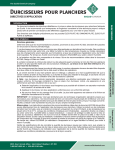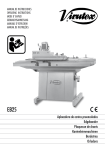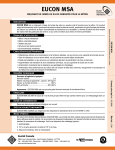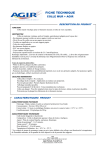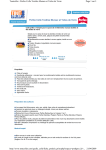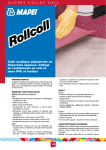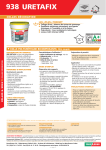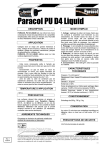Download CONSEILS DE POSE Ce qu`il vous faut Colle à papier peint, table à
Transcript
CONSEILS DE POSE Ce qu’il vous faut Colle à papier peint, table à encoller, escabeau, seau et bâton pour mélanger la colle, éponge, brosse à encoller, brosse de tapissier, pinceau (pour les raccords), règle de maçon ou grande règle, niveau à bulle ou fil à plomb, mètre ruban, crayon, ciseaux, couteau à enduire (ou règle à araser), cutter. A savoir Le mur (ou la surface à tapisser) doit être lisse, sain, sec et propre. Enduire et poncer la surface pour éliminer les imperfections. Choisir une colle cellulosique pour papier lourd. Commencer la pose au milieu du mur. Le premier lé doit être parfaitement vertical. Un papier est dit à raccord quand ses motifs se trouvent à cheval sur eux lés posés côte à côte. Dans ce cas, chaque lé doit être découpé de façon à pouvoir se raccorder avec le lé voisin. La hauteur du raccord est indiquée sur le rouleau. Le papier peint se pose à joint vif, c’est à dire bord à bord. Ce papier lavable peut être tamponné avec une éponge humide pour éliminer une tâche, mais il est déconseillé de le frotter. Durant l’encollage et la pose, garder à portée de main un seau d’eau claire et une éponge pour enlever les traces de colle ou se laver les mains. Pour de meilleurs résultats, nous vous recommandons de poser un papier de fond de bonne qualité. Attendre qu’il soit complètement sec pour procéder à la pose du papier définitif. Pour faciliter la pose et la dépose du papier peint en prévision d’un changement de décor, il suffit de pré encoller le mur la veille de la pose avec de la colle à papier peint. Les lés sont ensuite encollés et posés normalement. La préparation Préparer la colle en suivant son mode d’emploi. Bien mélanger pour éliminer les grumeaux. Dépoussiérer le mur avec une brosse humide. Tracer une ligne verticales au milieu du mur, allant du plafond au sol. C’est l’axe le long duquel vous poserez le premier lé. La découpe Mesurer la hauteur à tapisser et ajouter 10 cm, pour les coupes d’arasement en haut et en bas. Dérouler un rouleau sur la table et repérer la longueur qui vient d’être calculé. Replier le papier sur lui-même et marquer le pli. Découper le lé aux ciseaux ou au cutter et à la règle. Découper les lés au fur et à mesure pour éviter toute erreur. Si le papier comporte des motifs, découper les lés de sorte que les motifs correspondent entre eux. L’encollage Encoller la moitié de la longueur du lé, en commençant par le milieu. S’assurer que les bords sont correctement encollés. Replier le papier encollé sur lui-même et encoller l’autre moitié. Replier le papier vers le centre, comme précédemment. Ne pas détremper le papier au risque de provoquer un rétrécissement visible aux joints. L’affichage Déplier la partie haute du lé en haut du mur, en laissant dépasser de quelques centimètres sur le plafond. Positionner précisément le premier lé le long de l’axe vertical tracé sur le mur. Déplier la seconde moitié du lé et la laisser tomber le long du mur. Le marouflage Avec la brosse de tapissier, chasser toutes les bulles d’air, en travaillant de haut en bas et du centre vers les bords, pour faire adhérer le papier sur le mur. Le papier humide étant fragilisé, il est recommandé de ne pas trop le tirer ou le brosser trop fort, des déchirures ou des intervalles peuvent apparaître en séchant. Suite de la pose Poser le lé suivant en veillant à ce qu’il soit parfaitement jointif. Pour cela, il suffit de la faire glisser, dès que le haut a été affiché. Maroufler le lé posé, puis le raccord entre les deux lés avec la brosse de tapissier (tapoter le joint). Si le raccord entre deux lés colle mal, soulever légèrement le bord du papier, déposer un peu de colle avec un pinceau et maroufler de nouveau. Si la colle a débordé sur le papier, enlevez-la aussitôt avec une éponge propre et mouillée d’eau claire. Pensez également à laver l’ensemble des derniers lés posés à l’éponge sur la totalité de leur surface. Une fois sèche la colle sera impossible à enlever et l’aspect du papier risque d’en être fortement altéré. L’arasage Après avoir posé plusieurs lés, araser en bordure de plinthe et de plafond, utiliser un cutter en le guidant sur le couteau à enduire large, fermement appuyé dans l’angle. L’idéal est d’utiliser une règle d’arasage spéciale. La glisser sous le lé, en appui sur le dessus de la plinthe ou contre le plafond. On peut aussi marquer le pli dans l’angle, le tracer au crayon, puis découper le papier encore humide avec des ciseaux bien aiguisés et le recoller avec la brosse de tapissier. Les découpes irrégulières Autour d’une poutre, tracer la découpe au crayon sur l’envers du papier. Découper ensuite avec des ciseaux en prévoyant une petite marge, puis ajuster au cutter. Autour d’un interrupteur ou d’une prise en applique, utiliser des ciseaux pointus pour obtenir un arasage précis. Si l’appareillage est encrassé, couper le courant au disjoncteur et démonter l’appareil. Appliquer le papier et découper au cutter les contours de la boîte d’encastrement remonter l’appareil en veillant à ce qu’il soit bien d’aplomb. ADVICE TO LAY THE PAPER What you need Paste for cellulosic and thick paper, work surface topaste, stepladder, pail and stick to mix the paste, sponge, one brush to paste and an other one to lay the paper, paintbrush (to touch up), big ruler, spirit level, tape measure, pencil, scissors, small trowel, cutter. A few things you must know before starting The wall (or the area you want to paper) has to be smooth, clean and dry. To smear and rub down the area to erase imperfections. To begin the laying in the middle of the wall. The first sheet of paper has to be perfectly vertical. The wallpaper can be cleaned with a wet sponge to erase stains but we advise you against rubbing it. During the pasting and the laying, keep a pail full of clean water and a sponge next to you to erase stains or to wash your hands. For better results, we advise you to lay a white thin paper before laying the final one. To make the laying easier (and if you want to clear the wall easily later on to redecorate), you have to put some paste on the wall the day before. The sheets of paper will be laid normally the following day. Preparation To prepare the paste according to its instructions. You have to mix a lot to avoid lumps. To dust the wall with a wet brush. With the spirit level, to draw a vertical line in the middle of the wall, from the floor to the ceiling. You will lay the first sheet of paper along the line. How to cut To measure the height of the area you want to paper and to add up 10 cm (at the bottom and at the top of the sheet). To unroll a roll on the work surface and to measure the same length. To fold up the paper on itself and put a mark on the pleat. To cut the sheet with scissors or with the cutter and along the ruler. To cut the sheet as the work proceeds to avoid errors. If the paper has patterns, to pay attention to them (they have to match with the others you have laid before). Pasting To paste half a sheet and to begin with the middle. To be sure that the edges are correctly pasted. To fold up the pasted paper and to paste the other half (to let a few centimeters exceed on the ceiling). To let the first sheet precisely along the line you drew earlier. To unfold the other part of the sheet and to drop it along the wall. With a brush to lay the paper, to erase all the bubbles (to rub the paper gently with the brush, from the ceiling to the floor and from the middle of the sheet to the edges to make the paper stick correctly on the wall. Wet sheets of paper are fragile, do not rub them too hard or tears could appear when it is dry. To lay the other sheets of paper (do not leave blank space between them). When the upper part of the sheet is correctly laid, to let slip the other part along the wall. To rub gently the laid sheet and the join between the two sheets. If the join between two sheets doesn’t stick correctly, to lift gently the edge of the sheet, to put some paste with a paintbrush and then, to rub gently again. If there is some paste on the other side of the sheet, to wash immediately with a clean sponge and some clean water. If the paste gets dry, you won’t be able to wash it and the paper could be damaged. How to cut the exceeding paper on the ceiling and the floor After having laid several sheets, to cut the exceeding paper along the skirting boards and the ceiling : to use a cutter to cut along the small trowel (the trowel must be leant firmly against the wall). You could use a ruler (made for this use) for better results. To put it under the sheet, you have to maintain the ruler (or the trowel) firmly against the skirting boards or against the ceiling. You can also mark the pleat with a pencil in the angle, then you can cut the paper (which must be still wet) with well sharpened scissors and finally paste it again on the wall. How to cut along uneven areas Around beams, to draw the line for the cutting with a pencil on the other side of the paper. Then, to cut with scissors and to try to leave a little exceeding paper and finally, to adjust with the cutter. Around switches or plugs, to use a cutter to cut precisely around them. If the switches or the plugs are dirty, to switch off the current and remove them. To lay the paper and to cut the shape of the plug with a cutter. Finally, to put it again and to make sure that it has been done properly.


